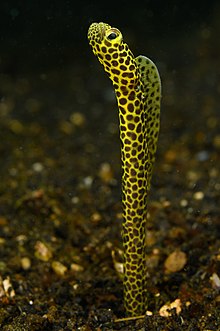| This article's lead section may be too short to adequately summarize the key points. Please consider expanding the lead to provide an accessible overview of all important aspects of the article. (January 2021) |
| Taylor's garden eel | |
|---|---|

| |
| Conservation status | |
 Data Deficient (IUCN 3.1) | |
| Scientific classification | |
| Domain: | Eukaryota |
| Kingdom: | Animalia |
| Phylum: | Chordata |
| Class: | Actinopterygii |
| Order: | Anguilliformes |
| Family: | Congridae |
| Genus: | Heteroconger |
| Species: | H. taylori |
| Binomial name | |
| Heteroconger taylori Castle & Randall, 1995 | |
Taylor's garden-eel (Heteroconger taylori) is a heteroconger belonging to the family Congridae. It is native to the central Indo-Pacific.
Description
Taylor's garden-eel is a small fish that can reach a maximum length of 48 cm. Its body is anguiform (eel-like): long, thin, with a circular cross-section (20 mm in average diameter) and a head of the same diameter as the body.
The body is white to yellowish and covered with many small black spots with patterns that vary from one individual to another and may include circular mottling or labyrinthine patterns. The dorsal fin always has a simple speckle pattern.
Distribution and habitat
The species is widespread throughout the tropical waters of the western central Indo-Pacific from the Philippines to Papua-New-Guinea and Indonesia.
It lives solitary or in small colonies on sandy bottoms in association with seagrass meadows, at depths between 5 and 15 m deep. It digs a burrow from which emerges about a third of its body. The eel then points its mouth towards into the current to catch drifting food.
Biology
Taylor's garden-eel feeds on zooplankton which it spots with its large eyes. As in other heteroconger species, individuals rarely leave their burrow once it is finished, but will shift burrows closer together during breeding season until contact between partners is possible. Fertilized eggs and juveniles have a planktonic period before reaching sufficient size to start living in the substrate.
Conservation status
The IUCN redlist currently lists Taylor's garden eel as Data Deficient, due to a lack of information on the population statistics. It is suspected that the population, due to its tendency to inhabit seagrass meadows, may be at risk on behalf of threats affecting seagrass in the region of Indonesia.
References
- ^ McCosker, J.E. (2010). "Heteroconger taylori". The IUCN Red List of Threatened Species. 2010. IUCN: e.T154752A4625533. doi:10.2305/IUCN.UK.2010-4.RLTS.T154752A4625533.en. Retrieved 15 January 2018.
- ^ Castle, P.H.J.; Randall, J.E. (1999). "Revision of Indo-Pacific garden eels (Congridae: Heterocongrinae), with descriptions of five new species". Indo-Pac. Fish. 30.
- Kuiter, R.H.; Tonozuka, T. (2001). Part 1. Eels - Snappers, Muraenidae - Lutjanidae. Pictorial guide to Indonesian reef fishes. Australia: Zoonetics.
- Froese, Rainer; Pauly, Daniel (eds.). "Heteroconger taylori". FishBase. September 2015 version.
- Allen, G.R.; Erdmann, M.V. (2012). Reef fishes of the East Indies. Tropical Reef Research. Vol. I–III. Perth, Australia: University of Hawai'i Press.
External links
- Photos of Taylor's garden eel on Sealife Collection
| Taxon identifiers | |
|---|---|
| Heteroconger taylori | |
This Anguilliformes article is a stub. You can help Misplaced Pages by expanding it. |